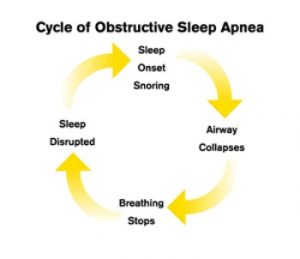For most of us who have no medical background, we don't necessarily try to make sense of everything that is happening to us. For instance, if you snore or your partner does, then that’s simply it. You or your partner snores. Irritating as it may be and leaves you deprived of precious sleep, snoring is just the tip of the iceberg. It is the characteristic symptom of a more serious sleeping disorder that is known as sleep apnea.
 However, that term does not make any sense to us lay people. What does it have to do with snoring? What happens when you sleep if you have it? How can you tell that your snoring is due to sleep apnea? To better understand what sleep apnea is all about and how deadly it is, read on.
However, that term does not make any sense to us lay people. What does it have to do with snoring? What happens when you sleep if you have it? How can you tell that your snoring is due to sleep apnea? To better understand what sleep apnea is all about and how deadly it is, read on.
Sleep apnea is highly prevalent in patients with cardiovascular disease. These disordered breathing events are associated with a profile of perturbations that include intermittent hypoxia, oxidative stress, sympathetic activation, and endothelial dysfunction, all of which are critical mediators of cardiovascular disease. Evidence supports a causal association of sleep apnea with the incidence and morbidity of hypertension, coronary heart disease, arrhythmia, heart failure, and stroke. Several discoveries in the pathogenesis, along with developments in the treatment of sleep apnea, have accumulated in recent years. In this review, we discuss the mechanisms of sleep apnea, the evidence that addresses the links between sleep apnea and cardiovascular disease, and research that has addressed the effect of sleep apnea treatment on cardiovascular disease and clinical endpoints. Finally, we review the recent development in sleep apnea treatment options, with special consideration of treating patients with heart disease.
(Via: http://www.medscape.com/viewarticle/876364)
In short…
About 60 percent of everybody who snores has some degree of sleep apnea.
Snoring and having been witnessed to have pauses in breathing increases the likelihood of having sleep apnea to upwards of 80 percent.
Obstructive sleep apnea is caused when the muscles in the airway relax/collapse, preventing the sleeper from breathing until the sleeper arouses from the apnea.
Apneas can last more than a minute, and the associated arousals are disruptive to sleep (although it is rare for the sleeper to be aware of the apneas or arousals).
Someone with moderate sleep apnea will have 15 to 30 apneas in an hour.
Some people with severe sleep apnea can stop breathing more than 100 times an hour.
It’s important to identify and treat sleep apnea (which will eliminate snoring) not only to improve sleep quality, but because of the health risks associated with untreated sleep apnea.
Things like hypertension, stroke, diabetes, heart attack, atrial fibrillation and depression are just a few of the health risks that come with sleep apnea.
By now you probably have a clearer understanding of this sleeping disorder and what happens to your body when you are diagnosed with it. While we often associate snoring with adults, kids can snore too and likewise suffer from sleep apnea. And considering their young age and growing body, such a condition can have detrimental effects on their health and well-being.
A recent study set out to investigate the effect of sleep apnea on the brains of 7- to 11-year-olds. In total, 16 children with obstructive sleep apnea were evaluated at the University of Chicago's pediatric sleep laboratory. All children underwent neurocognitive tests and were scanned using MRI.
The study team was headed up by Dr. Leila Kheirandish-Gozal, director of pediatric clinical sleep research at the University of Chicago. The team worked in conjunction with researchers from the University of California at Los Angeles, who analyzed the images.
The test results and brain scans were compared with a further nine children without sleep apnea, matched for gender, age, weight, and ethnicity. They also compared the children with sleep apnea with a database of 191 MRI scans in a pre-existing National Institutes of Health (NIH) database.
Once the analysis was complete, the results were striking. The children with obstructive sleep apnea had substantial reductions in the volume of gray matter - the information processing part of the brain.
(Via: http://www.medicalnewstoday.com/articles/316437.php)
It is a parent’s responsibility to ensure that young children get enough sleep as they grow up. A growing body not only needs proper diet, supplementation, and active play but enough sleep at night as well. And when in the unfortunate event that a young child already snores and suffers from sleep apnea, see a doctor right away to undergo a sleep test to get a diagnosis.
Kids may have a hard time complying with a CPAP treatment. Even adults struggle with it too. But knowing how breathing is affected during sleep by this sleep disorder, it is important to take action right away or put their health and life at risk. Not all the time surgery is warranted to really beat sleep apnea. Check this out https://snoringmouthpiecereview.org/zquiet because it is an anti-snoring mouthpiece that children can conveniently use. Or, try a similar solution with this alternative mouthpiece: https://snoringmouthpiecereview.org/snorerx. Kids can manage to sleep soundly at night with these mouthpieces in place, unlike other sleep apnea managements that are not quite kid-friendly.
What Exactly Is Sleep Apnea? See more on: The Snoring Mouthpiece Review Blog
source https://snoringmouthpiecereview.org/snorerx/what-exactly-is-sleep-apnea
No comments:
Post a Comment